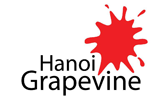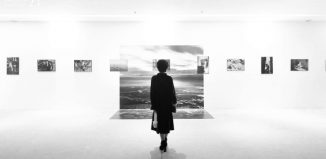ONCE UPON A BRIDGE IN VIETNAM – A story by François Bibonne

Written by François Bibonne for Hanoi Grapevine
Kindly credit Hanoi Grapevine when sharing the article
Please do not copy or repost without permission
François Bibonne is a young French documentary filmmaker whose grandmother is Vietnamese. Looking for his connection with Vietnam, he spent 15 months in the country to explore the classical music scene in Vietnam and wrote for Hanoi Grapevine about his epic journey.
Also, please check out his beautiful documentary video trailer and support him here so that he can complete his meaningful project
My name is François Bibonne and I spent 15 months in Vietnam exploring the country of my grandmother, Therese Nguyen Thi Koan.
Why Vietnam?
My trip to Vietnam started with a tiny blue suitcase and my iPhone at Roissy Airport. I developed the idea of making a documentary about western classical music in Vietnam in 2019 during my internship at a classical music label in Paris. I was making the tour schedule of the artists going to London, Amsterdam, Tokyo, New York or Seoul, when I suddenly asked myself: what about Vietnam? Do classical musicians perform there? Do they have an orchestra? What is the classical music scene like in Hanoi – the city of my grandmother?
I already had a private vision of Vietnam, as I had worked in a travel agency there for three months the previous year. So I booked my ticket when I received my last month’s salary in January; then I headed to Vietnam one month later. At that time, people used to think Asia was a dangerous place to go because of the first covid-19 wave in China. So when I told my friends and relatives about my project, they didn’t realize I was serious. I didn’t myself realize that I was about to start a project that might change my life.

First impression
My first impression of the music scene in Vietnam was totally unreal. It was quick to network with the community thanks to Facebook and the help of the Japanese music director of the Vietnam National Symphony Orchestra Honna Tetsuji but the epidemic stopped concerts until the summer. I was surprised to be invited to the magistral concert of the Vietnam National Symphony Orchestra celebrating the 75th anniversary of the Police Ministry. I even got the chance to meet Tô Lâm – the Police Minister of Vietnam at that time. The main difference I noticed was that the program used traditional instruments and folk songs with the orchestra, as well as the beauty of the Vietnamese language, an interest which will raise many questions for the documentary in the future.
Then the concert “We return” happened at the Vietnam National Academy of Music, connecting the three main music institutions of the city (VNAM, VNOB and VNSO). I remember Pini Di Roma (Resphighi) very well. When you don’t know a country, you directly imagine the place as a whole and the music becomes a symphonic poem in your head. I was very moved by the performance and I started to realize how great the classical music scene is in Hanoi. The second difference I noticed during my research was the age of the audience – an amazingly young group of people around 30 years old.


Trips
Then I had the opportunity to meet the Ho Chi Minh City Ballet and Symphony Orchestra. The feeling was quite different in Saigon. A lot of musicians spoke French to me: violist Phạm Vũ Thiên Bảo, violinist Lê Minh Hiền, and conductor Trần Vương Thạch. They told me about Camille Saint-Saëns’ trip to Con Dao in 1895, where he finished the opera Fredegonde. The story moved me, since the composer wrote a nice text about Vietnamese music and against the violence committed by the French colonial regime. Classical music is a nice frame to remember inspiring stories from Indochina.
It also took some trips outside of Hanoi, in the countryside.
One was the brass culture coming from the French catholics in Nam Dinh province. I travelled with the help of Truyền hình thông tấn reporters and discovered how brass instruments are manufactured in a professional way. One French trumpet dated from 1872.
The other nice trip I made to the countryside took place near Bắc Giang in Then village. Generations of farmers play violin there, and I had the chance to listen to the teacher and his students performing “trống cơm”. This folk song is sometimes played by orchestras. This was very original for me, as a foreigner, because no one would expect a string music school based in an old temple far from the city. In the middle of the rice fields, it released a special atmosphere that nobody can forget.
I also went to study quan họ culture in Bac Ninh Province. I have always been interested in the Vietnamese language and the way they bend sound. The singing culture in Vietnam made me think again of the first concert I attended at the National Convention Center at the Police Ministry, and also of Ca Tru music – I had the chance to meet the royal family of Ca trù music in Hanoi as well.
Back to the roots: Hanoi, Yen Bai
Back to Hanoi, I met the musicians of Schubert in the Mug (Phan Đỗ Phúc, Patcharaphan Khumprakob, Hoàng Hồ Thu), the Hanoi Brass community (Xu Pham, Yuki Urushihara) and the Hanoi Saigon baroque orchestra (Tố Như Lương). They all share the project of developing a national interest for chamber music in Vietnam and strengthening the classical music community. Whether it’s with the Goethe Institute or with the French community, they all want to connect people through music and create a new market for classical musicians in Vietnam.

The last project I want to mention is a story that involves a traditional musician who helped me at the end of my trip. Phan Thuỷ was the music director of a project which aims to promote the forest of Yen Bai province and urge people to fundraise a reforestation plan. This is a very nice story. I felt that nature called me back. Something saying “You are going to Vietnam and you want to study western classical music? Come on. Wake up! There is much more there!”
In the trailer, you can hear Những kỷ niệm quê hương composed by Hoàng Dương and played by the Vietnam National Symphony Orchestra, and Echo Sound composed by Hồ Hoài Anh, Arr. Phan Thủy, played by The Green Sound.
My methodology
I did around 20 interviews. Most of them were with both artists and music managers. All of them want to develop society with music. My methodology was unclear because I only had myself to put constraints, but I managed to frame my curiosity with three imperatives. T
he first was to break down barriers between generations. Usually people from the generation above 60 helped me to understand music history, people from the generation between 40 and 60 helped me understand what’s going on now in the institutions and how things work, and people from the one below caught energetic musicians with creative projects for the XXI century.
I also noticed the strong energy from the women in Vietnam, which is a matriarchal society.

And now ?
I’m now editing the documentary with two professional editors in Fontainebleau. This is a very important place for me, where I’m shooting another documentary, Once upon a bridge in Fontainebleau, which tells the story of the first international music school that connected American musicians and French music teachers after World War One. My work is all about bridges between countries through music in order to better understand music history and make smart projects in the future.
My next documentary in Vietnam will deal with the traditional and contemporary scene between Vietnamese instruments and electronic sounds. I plan to visit the center of Vietnam, Hué, and the highland mountains with a focus on gong music near Dalat. That is part of the Dong Son culture, which is one of the worldwide foundations of music history. Some interesting projects are also in Saigon for the Vietnamese contemporary scene, which is a bit too associated with Hanoi globally.
Support François Bibonne documentary here















